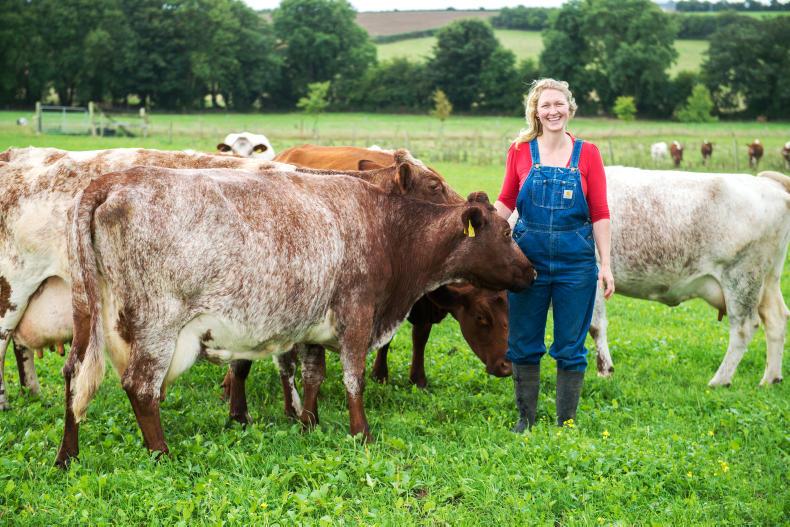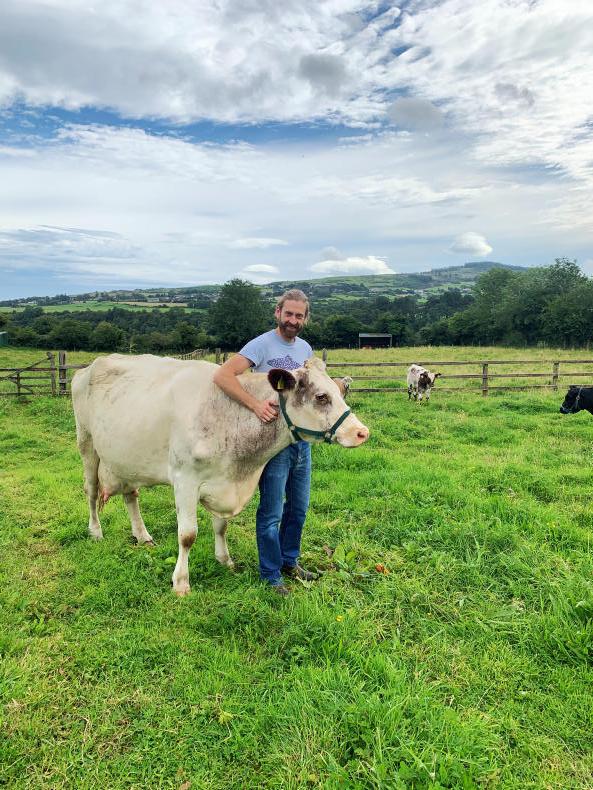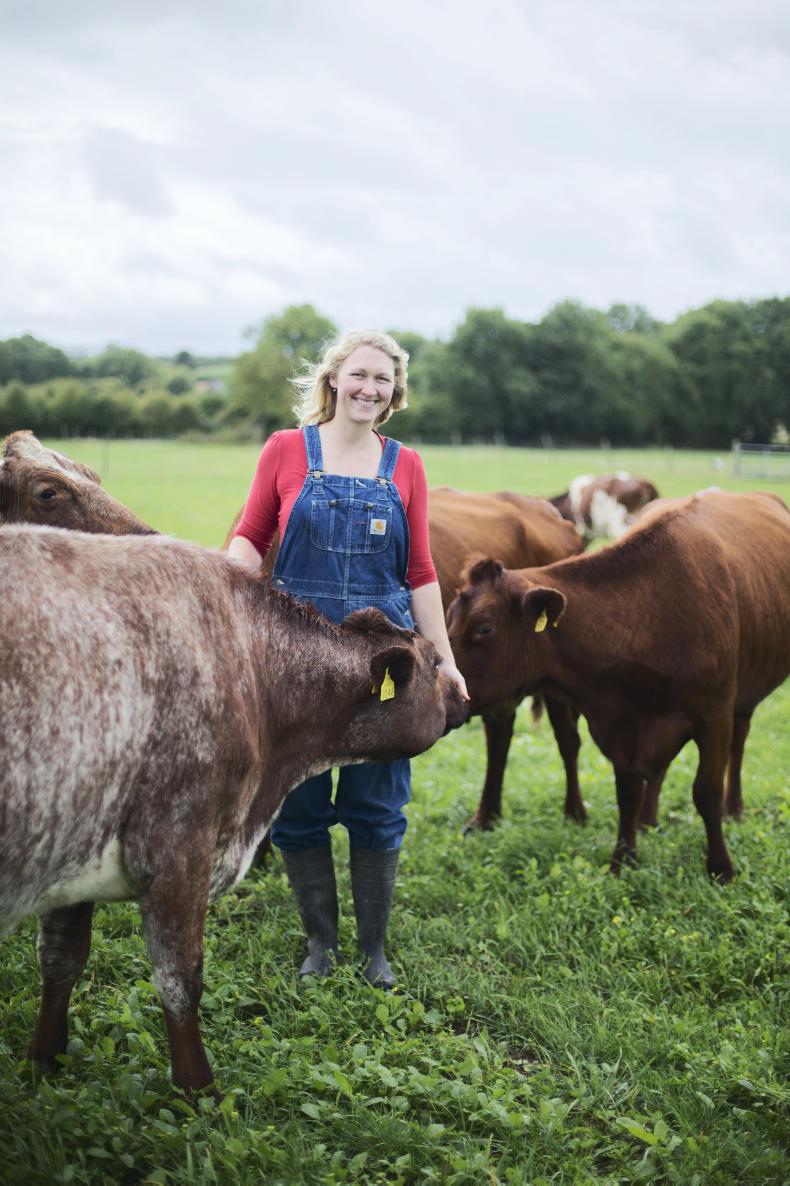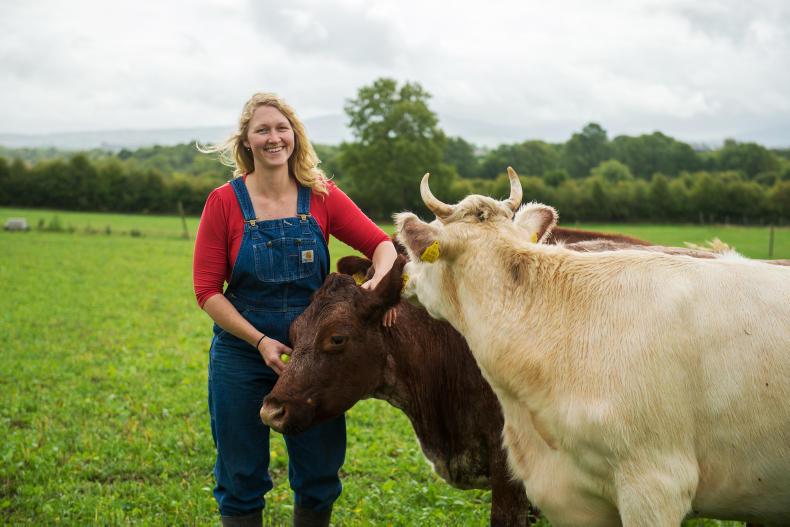Often calm and pleasant, small holders will tell you cows are not only a joy to raise – they can provide plenty of nutrient-rich food for you and your family.
There aren’t many in Ireland who keep just one cow for milking – there is hard work and significant start-up expense involved – but it wasn’t so long ago when having a family cow was the norm among rural Irish families.
Irish Country Living spoke with Mimi Crawford from Crawford’s Farm in Cloughjordan, Co Tipperary, and Olly Nolan, who milks two Shorthorn cows for personal use on his small holding in Dublin 24. Mimi and her husband, Owen, milk 13 Shorthorn and Shorthorn-Moiled cross cows and sell raw milk products (cream, milk and butter).
The Department of Agriculture requires all cow owners to register their animals under the Irish Bovine Animal Identification system. This is for animal welfare and biosecurity reasons. A herd number is required and cows must be tagged within 20 days of birth. You can learn more on the Department website (agriculture.gov.ie).
For shelter, you will need to provide appropriate indoor and outdoor spaces.
“You don’t need a massive amount, but you need a bit of infrastructure,” Mimi says. “A typical one-cow house would be around 4sq m, which is plenty of room. In terms of outdoor space, you could do a lot with two acres.”
Bovine tuberculosis (TB) is a serious concern and small holders must adhere to yearly testing. Other biosecurity measures include fencing (Olly uses a combination of sheep wire topped with two strands of electric fencing), access to a holding facility, like a cattle crush, and providing veterinary contact information.
“To get your herd number, you need to have a few things: a shelter for any sick animals and a few other indoor spaces,” Olly says. “I lucked out [when I bought this property]; all of my fields have shelters with concrete bases. Right now, I keep two Dexter yearlings, two cows and a calf [on 8.5ac] with no problems.”
Providing essential health care (worm medication, watching for mineral deficiencies, and gestational care for in-calf cows) is important.
Raw milk is legal to consume or sell, and there are some Irish farmers, like the Crawfords, who make their living from raw milk products. However, the Food Safety Authority of Ireland strongly warns against the consumption of raw milk, saying even under the most hygienic circumstances it could contain pathogens that could cause illness – especially in individuals with compromised immunity. Mimi says their customers look for raw milk for a number of reasons.
“Some buy for environmental reasons, since [raw milk sellers] are generally smaller scale,” she says. “Many buy for health reasons. Those who are allergic to milk can sometimes drink raw milk, if they’re allergic to the lactose and not the proteins; others drink it for gut health. And then, a lot of our customers just want what they used to have growing up.”

For anyone planning to sell raw milk to the public, there is a guide to specific legislation on the Raw Milk Ireland website (rawmilkireland.com). Raw milk requires extra testing for tuberculosis each year, as well as regularly scheduled somatic cell count (SCC) tests and tests for presence of harmful bacteria.
Olly sometimes drinks his cows’ milk raw, but he finds pasteurised milk lasts longer; making it his preferred method.
“I put the milk into glass bottles and then put them in a Burco boiler, set at 66°C for 30 minutes,” he says. “Then, I tighten the lid which creates a vacuum in the bottle.”
Counter-top pasteurisers can be purchased online (€569 at agridirect.ie), or milk can be gently heated on the stove top to pasteurise.
With pig and poultry rearing, commercial breeds are often preferred for their quick growth, accessibility and lower overall costs. When it comes to cows, however, commercial breeds might be too productive for one family.
“You could buy a Fresian calf really easily, but you’ll get a lot of milk – possibly too much – and you might need more space [because they’re larger],” Mimi says.
A smaller-sized, dual-purpose breed is preferred by most Irish small holders, like Olly, who keeps Dexters for beef and milks his Shorthorns. Most small holders put their cow in calf each year, to keep up milk production, and keep calves for beef or to replace an older milking cow (which can also be used for beef, if healthy, once retired).

Small holder Olly Nolan with his Shorthorn dairy cow, Vespa, on his farm in Co Dublin.
“We would milk once a day and have the calf suckle until self-weaned and either slaughter that animal or use it as a replacement for the cow being milked,” Mimi says. “To do that, having a dual purpose animal is much better. A Jersey is another great option for milk, and they’re fine for beef, as well.”
Olly originally milked his Dexter, getting about 2l of milk per day. He gets much more from his Shorthorns (up to 15l/day). He milks his cows until six months gestation, before drying them off for the remaining three. He uses artificial insemination for breeding (costing around €40 for Shorthorn AI). For information on available breeds in Ireland, cows.ie is a good resource.
Both Mimi and Olly say cows in small holdings rarely require supplementary feed, if they have enough grass and fodder.
“Many farmers will supplement for production increase,” Mimi says. “If you’re milking for yourself, you don’t need to worry about that.”
Olly’s cows are almost entirely grass fed. He has a small tractor (rare for a small holder) and will make his own silage or haylage for winter feed. His beef cows remain 100% grass fed, while his dairy cows get an extra treat.
“One of the local [beer] breweries gives me their spent grain and I give that to the two cows,” he says.

Others may want to use supplementary feed specific to dairy production, minerals or for pre-calving cows. Detailed nutritional information on feeding cows for dairy production can be found on the Teagasc website (teagasc.ie).
Compliance in hygiene and food safety legislation is essential for dairy production (specific information can be found at fsai.ie). Many small holders milk once per day; Olly is currently milking just three times per week.
Hand milking is entirely possible, though it can be difficult at first. Mimi says, when hand milking a cow, there are a few things you should have.
“When we had three cows we just hand milked,” she says. “All you do is milk into a bucket and get a strainer and a filter.”
Olly uses milk for drinking, but also makes butter, yoghurt and cheese. He started out hand milking and eventually invested in a small milking machine. A stainless steel strainer and filter retails for €235 and a stainless steel milk bucket is €180, while portable cow milking units can be purchased for €950 (all prices from farmanddairyspares.ie). Olly recommends a good quality cream and milk separator, which retails at €259 (agridirect.ie).
Read more
Breaking the grass ceiling: the female farmers daring to be different
Follow your gut
Often calm and pleasant, small holders will tell you cows are not only a joy to raise – they can provide plenty of nutrient-rich food for you and your family.
There aren’t many in Ireland who keep just one cow for milking – there is hard work and significant start-up expense involved – but it wasn’t so long ago when having a family cow was the norm among rural Irish families.
Irish Country Living spoke with Mimi Crawford from Crawford’s Farm in Cloughjordan, Co Tipperary, and Olly Nolan, who milks two Shorthorn cows for personal use on his small holding in Dublin 24. Mimi and her husband, Owen, milk 13 Shorthorn and Shorthorn-Moiled cross cows and sell raw milk products (cream, milk and butter).
The Department of Agriculture requires all cow owners to register their animals under the Irish Bovine Animal Identification system. This is for animal welfare and biosecurity reasons. A herd number is required and cows must be tagged within 20 days of birth. You can learn more on the Department website (agriculture.gov.ie).
For shelter, you will need to provide appropriate indoor and outdoor spaces.
“You don’t need a massive amount, but you need a bit of infrastructure,” Mimi says. “A typical one-cow house would be around 4sq m, which is plenty of room. In terms of outdoor space, you could do a lot with two acres.”
Bovine tuberculosis (TB) is a serious concern and small holders must adhere to yearly testing. Other biosecurity measures include fencing (Olly uses a combination of sheep wire topped with two strands of electric fencing), access to a holding facility, like a cattle crush, and providing veterinary contact information.
“To get your herd number, you need to have a few things: a shelter for any sick animals and a few other indoor spaces,” Olly says. “I lucked out [when I bought this property]; all of my fields have shelters with concrete bases. Right now, I keep two Dexter yearlings, two cows and a calf [on 8.5ac] with no problems.”
Providing essential health care (worm medication, watching for mineral deficiencies, and gestational care for in-calf cows) is important.
Raw milk is legal to consume or sell, and there are some Irish farmers, like the Crawfords, who make their living from raw milk products. However, the Food Safety Authority of Ireland strongly warns against the consumption of raw milk, saying even under the most hygienic circumstances it could contain pathogens that could cause illness – especially in individuals with compromised immunity. Mimi says their customers look for raw milk for a number of reasons.
“Some buy for environmental reasons, since [raw milk sellers] are generally smaller scale,” she says. “Many buy for health reasons. Those who are allergic to milk can sometimes drink raw milk, if they’re allergic to the lactose and not the proteins; others drink it for gut health. And then, a lot of our customers just want what they used to have growing up.”

For anyone planning to sell raw milk to the public, there is a guide to specific legislation on the Raw Milk Ireland website (rawmilkireland.com). Raw milk requires extra testing for tuberculosis each year, as well as regularly scheduled somatic cell count (SCC) tests and tests for presence of harmful bacteria.
Olly sometimes drinks his cows’ milk raw, but he finds pasteurised milk lasts longer; making it his preferred method.
“I put the milk into glass bottles and then put them in a Burco boiler, set at 66°C for 30 minutes,” he says. “Then, I tighten the lid which creates a vacuum in the bottle.”
Counter-top pasteurisers can be purchased online (€569 at agridirect.ie), or milk can be gently heated on the stove top to pasteurise.
With pig and poultry rearing, commercial breeds are often preferred for their quick growth, accessibility and lower overall costs. When it comes to cows, however, commercial breeds might be too productive for one family.
“You could buy a Fresian calf really easily, but you’ll get a lot of milk – possibly too much – and you might need more space [because they’re larger],” Mimi says.
A smaller-sized, dual-purpose breed is preferred by most Irish small holders, like Olly, who keeps Dexters for beef and milks his Shorthorns. Most small holders put their cow in calf each year, to keep up milk production, and keep calves for beef or to replace an older milking cow (which can also be used for beef, if healthy, once retired).

Small holder Olly Nolan with his Shorthorn dairy cow, Vespa, on his farm in Co Dublin.
“We would milk once a day and have the calf suckle until self-weaned and either slaughter that animal or use it as a replacement for the cow being milked,” Mimi says. “To do that, having a dual purpose animal is much better. A Jersey is another great option for milk, and they’re fine for beef, as well.”
Olly originally milked his Dexter, getting about 2l of milk per day. He gets much more from his Shorthorns (up to 15l/day). He milks his cows until six months gestation, before drying them off for the remaining three. He uses artificial insemination for breeding (costing around €40 for Shorthorn AI). For information on available breeds in Ireland, cows.ie is a good resource.
Both Mimi and Olly say cows in small holdings rarely require supplementary feed, if they have enough grass and fodder.
“Many farmers will supplement for production increase,” Mimi says. “If you’re milking for yourself, you don’t need to worry about that.”
Olly’s cows are almost entirely grass fed. He has a small tractor (rare for a small holder) and will make his own silage or haylage for winter feed. His beef cows remain 100% grass fed, while his dairy cows get an extra treat.
“One of the local [beer] breweries gives me their spent grain and I give that to the two cows,” he says.

Others may want to use supplementary feed specific to dairy production, minerals or for pre-calving cows. Detailed nutritional information on feeding cows for dairy production can be found on the Teagasc website (teagasc.ie).
Compliance in hygiene and food safety legislation is essential for dairy production (specific information can be found at fsai.ie). Many small holders milk once per day; Olly is currently milking just three times per week.
Hand milking is entirely possible, though it can be difficult at first. Mimi says, when hand milking a cow, there are a few things you should have.
“When we had three cows we just hand milked,” she says. “All you do is milk into a bucket and get a strainer and a filter.”
Olly uses milk for drinking, but also makes butter, yoghurt and cheese. He started out hand milking and eventually invested in a small milking machine. A stainless steel strainer and filter retails for €235 and a stainless steel milk bucket is €180, while portable cow milking units can be purchased for €950 (all prices from farmanddairyspares.ie). Olly recommends a good quality cream and milk separator, which retails at €259 (agridirect.ie).
Read more
Breaking the grass ceiling: the female farmers daring to be different
Follow your gut








SHARING OPTIONS